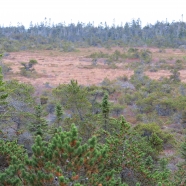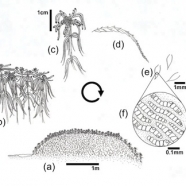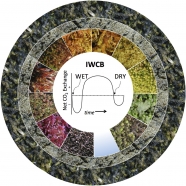Sphagnum magellanicum
Our comparative studies focus on water and carbon dynamics in the genus Sphagnum. Here a dense colony of Sphagnum magellanicum shows the exchange surface for water loss and carbon uptake. In bryophytes, shoots also function in water transport, water holding and nutrient uptake; such alternative functional demands have led to functional trait relationships that differ significantly from vascular plants.
Read MoreGreat Waas Island Preserve
Beginning in 2013, we have participated in a global study of productivity in Sphagnum using two widespread, important peat forming species, S. fuscum and S. magellanicum. Organized by Gustaf Granath and Häkin Rydin from Uppsala Univ. and working on our study sites in New York and Maine with Sean Robinson (SUNY Oneonta), we are partnering with investigators from North America, Europe and Asia to better understand relationships among climate, nitrogen deposition and productivity in Sphagnum. We are also working with Dave Gillikin and Anouk Verheyden-Gillikin of the Stable Isotope Lab at...
Read MoreHierarchical Organization of Sphagnum Shoot Systems
Sphagnum exhibit a high degree of genetic and phenotypic variation in structure at all levels within their organization including (a) across hummock–hollow microhabitats, (b) within colonies, (c) within shoots that show variation in branch distribution and density, (d) on branches, (e) in leaf size and shape, and (f) in the size and arrangement of photosynthetic and hyaline cells. Variation at each of these organizational levels affects plant function (drawing by S. Webb; from Rice, SK 2009. Bryophytes. In Likens, GE (ed.), Encyclopedia of Inland Waters. Elsevier, Oxford,...
Read MoreSphagnum Productivity
My wife Jen taking notes at the field study plot of Sphagnum fuscum on Great Waas Island, Maine. This study is part of the Global Sphagnum Productivity Study.
Read MoreAdirondack High Peaks
Here I am on Seward Mountain, one of the 46 peaks above 4,000′ in New York’s Adirondack Mountains. In addition to supporting alpine bryophyte communities, this mountain is named for William H. Seward, Governor of New York, Secretary of State under Abraham Lincoln and noted alumnus of Union College.
Read MoreIntegrated Water-driven Carbon Balance Model and Bryophyte Color Wheel
Being desiccation tolerant, bryophytes exhibit different water and carbon relations than vascular plants. The unique dynamics are illustrated graphically showing net carbon assimilation through time beginning with a wetting event at the origin. Initially, plants have a burst of respiration where they upregulate metabolism and repair damaged tissues. Plants then engage in a period when they are sufficiently wet and photosynthetically active and show positive carbon balance. This is followed by the plant entering the desiccated state, where once again respiration dominates. In the figure...
Read More






